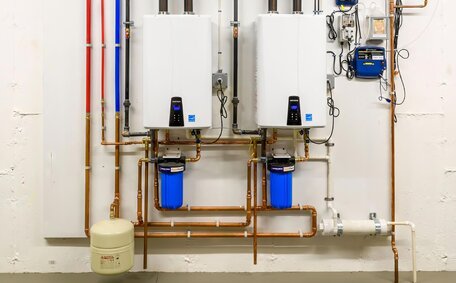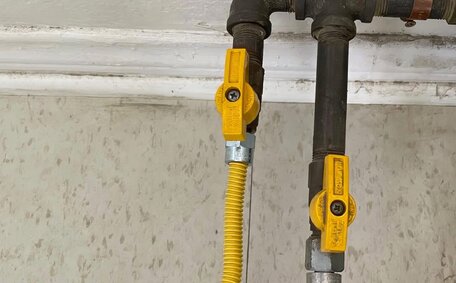
How Hard Water Hurts Hot Water Heaters
Hard water leaves mineral deposits in heaters, pipes and tanks. This limescale reduces efficiency, lifespan and hot water availability. Contact us for affordable water softening solutions.
Read MoreAdditional indicators of a gas leak include symptoms such as headaches, nausea, breathlessness and dizziness, which may indicate early exposure to carbon monoxide. Pets exhibiting distress behaviours can also be a warning of increasing gas levels indoors.
Outside your home, you may notice unusual changes in vegetation around a gas appliance or lines due to gas displacing air around plant roots.
Note that natural gas is colourless and odourless on its own. Thedistinctive rotten egg smell is added artificially with mercaptan to help detect leaks.
While the smell of gas is a key indicator of a leak, physical symptoms or changes in pet behaviour are also crucial warnings. Awareness of these signs enables quick detection and response in case of a gas emergency.
Your gas meter and main shutoff valve are typically housed within a protective casing on the exterior of your home, crucial for emergency gas shutdowns. Look for these near entryways, sidewalls, or boundary lines. Knowing how to use the main shutoff valve to turn off your gas is essential, as the location varies from property to property.
Before interacting with gas infrastructure, extinguish all open flames, such as cigarettes, to safely and easily use your gas shutoff. Shut down and disconnect any appliance gas units as a precaution using the safety shutoff valve if necessary. Having a flashlight within reach is indeed a good idea.
Meters for natural gas systems feature the main shutoff handle for halting gas supply. The unique setup of each system may necessitate a non-sparking wrench to operate the valve and cut off gas supply at the shutoff, intentionally located for emergency use. Some shutoff valves only need a quarter-turn, while others might require several full turns to activate the safety shutdown. For LPG systems, large cylinders may be fitted with a solenoid valve instead of a meter.
This is often referred to as the main shutoff in your gas system.
If you’re having difficulty and can’t locate your gas installation or emergency shutoff valve, please contact your utility company or a licensed gasfitter promptly for assistance to shut off your gas service. It’s critical to know where these vital spots are prior to an emergency event like a gas leak.
Ventilating the area is a critical initial measure when you suspect gas presence in your environment, before cutting off the supply. Here are the key actions to take:
After ventilation, follow the earlier steps to shut off the gas at your meter or cylinders. Ensure ventilation is done before turning off the gas to avoid ignition hazards.
After stopping the gas flow during a leak, it’s essential to prioritise safety and contact expert technicians to assess, identify, and fix the problem before reinstating gas service.
Attempting to address complex components like the gas line and its connections to various appliances without a licensed professional can lead to further issues. Attempting makeshift DIY repairs on gas lines or fittings risks further leaks, ignition, explosion, carbon monoxide poisoning, or other critical safety issues.
For detailed guidance on natural gas and LPG systems, contact our experts on our gas leak hotline at 1800 427 for immediate assistance from licensed gas fitting technicians. We are available 24/7 to respond promptly and ensure your gas system is restored safely.
Alternatively, email jobs@picnicpointplumbingservices.com.au or complete our online contact form to arrange an appointment. Be sure to provide your contact details including information on the type of leak, gas system, appliances affected and any other relevant information.
In a fire emergency, such as a significant gas blaze or any life-threatening situation, vacate the premises quickly and dial the emergency number on 000 as soon as you are in a secure location. However, for the majority of gas leak scenarios, before re-energising gas utilities, reach out to local emergency services as our skilled team is properly equipped and authorised to address the problem and prevent additional hazards.
Gas service should only be reinstated after a licensed gas fitter has thoroughly inspected the system and confirmed its safety. Reactivating gas or relighting appliances without professional approval risks leaks, explosions, and carbon monoxide poisoning, among other dangers.
After an emergency gas shut off, the technician will check the entire system, including:
Only once the gas fitter has confirmed through these safety checks that the system is fully repaired, reassembled correctly, and there are absolutely no remaining leaks or other issues, is it safe to start restoring gas supply.
The technician will switch the gas meter off during repairs and upon completion, turn the gas back on at the meter, ensuring gas your appliances are safely restored, then relight pilot lights and check burner function. You must avoid restoring your gas service yourself, as unsuccessfully repaired faults could result in additional shutoffs and further complications.
Rely on our seasoned, licensed gas fitters to decide the safe timing for restoring your gas service. We follow comprehensive procedures to certify repairs and restoration for peace of mind.
Your gas supply may come from natural gas via the main line or liquid petroleum gas stored in outdoor cylinders. Whether you need to shut off gas from the mains or LPG cylinders, the method of delivery differs between these gas types.
In Australia, gas is delivered underground to the property’s external meter, which is kept in the meter box. This meter monitors and controls gas flow to the home and includes a critical shutoff valve to turn off the gas during emergencies. An emergency shutoff valve is located on the meter to stop the gas supply in the event of a leak.
LPG, or liquid propane gas, however, relies on large refillable cylinders located on the property, either above or below ground. Each LPG cylinder has a valve to shut off the main gas supply, which needs to be closed individually in an emergency. A non-sparking wrench may be required to operate these valves.
While both systems use shutoff valves, natural gas is controlled by a central meter outside, managing the supply for the entire home. LPG systems use individual cylinders, with each one having its own valve for shutting off gas separately.
Hard water leaves mineral deposits in heaters, pipes and tanks. This limescale reduces efficiency, lifespan and hot water availability. Contact us for affordable water softening solutions.
Read MoreIt’s important to routinely check your gas appliances for any issues. Signs of problems include gas leaks, strange sounds, odd smells and more. Have a professional inspect your gas appliances annually and service them regularly for safety.
Read MoreUpgrading your gas meter is a simple process completed by registered technicians. It involves disconnecting your gas supply for 15 minutes to swap the old meter for a new digital smart meter. The upgrade is free and improves accuracy.
Read MorePicnic Point, 2213 NSW
We will call back as soon as possible.




